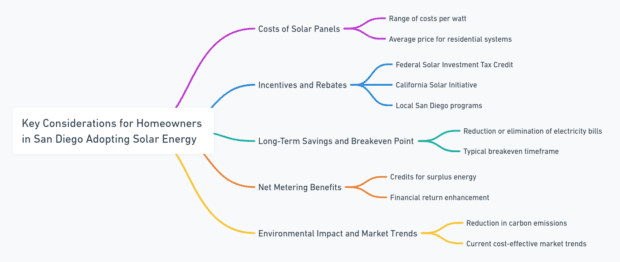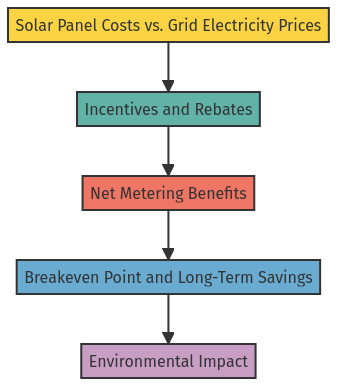In recent years, San Diego has emerged as a leader in the adoption of solar energy, spurred by California’s progressive renewable energy targets and the city’s plentiful sunlight.
Homeowners in San Diego are assessing the long-term savings afforded by solar panels against the rising costs of grid electricity.
Call now to get a free quote
Key Takeaways
- Solar panels offer San Diegans long-term savings compared to grid electricity, especially with net metering.
- Incentives and subsidies reduce upfront costs, sweetening the cost-benefit analysis of solar installations.
- Environmental and market trends enhance the appeal of solar energy over grid electricity.
Solar Panel Costs in San Diego
In San Diego, the solar panel market is thriving due to the area’s high exposure to sunlight and elevated grid electricity prices. Solar panel costs in the region typically range from $2.51 to $3.37 per watt, with various factors influencing the final price, such as the size of the system and available incentives.
A standard 5 kilowatt (kW) solar system—suitable for residential use—is commonly quoted before incentives. The pricing for such installations can fall between $12,204 and $16,850 on average, depending on the provider and system specifications.
After accounting for incentives like the federal tax credit, which offers a 30% reduction, the cost reduces significantly. Post-incentive prices see an average drop, taking the cost of a 5 kW system to approximately $10,500 to $14,358.
It’s noteworthy that prices per watt in San Diego are below the national average, which hovers around $3.00 per watt. This more competitive pricing is conducive to solar investments by homeowners and businesses alike, especially when considering the long-term savings on utility bills.
- Pre-incentive price range for a 5 kW system: $12,204 – $16,850
- Average cost per watt (post-incentive): $2.50 – $2.87

Grid Electricity Prices in San Diego
In San Diego, the cost of grid electricity is a crucial factor for households and businesses considering the switch to solar power. As of January 2024, residents are charged based on a tiered rate structure by San Diego Gas & Electric (SDG&E).
The tiered rates are as follows:
- Tier 1: 38.4 cents per kWh
- Tier 2: 48.3 cents per kWh
The absence of a third tier, previously known as the High Use Charges (HUC) tier, simplifies the billing process. The same rates apply for summer (June-October) and winter (November-May) billing periods with the Schedule DR rates.
Cost-Benefit Analysis
When considering solar panels in San Diego, homeowners must weigh the initial investment against long-term savings and determine the breakeven point to assess the true value of a solar installation compared to traditional grid electricity.
Investment Costs
Investment costs for residential solar installations in San Diego encompass hardware like panels and inverters, as well as soft costs such as permitting, installation, and connection to the grid.
The National Renewable Energy Laboratory provides a detailed breakdown of these expenses, indicating that costs vary depending on factors like system size and installation type. As of recent data, the average cost for residential solar systems is approximately $16,000, with a range that can fluctuate between $4,500 to $36,000.
Long-Term Savings
Solar panels significantly reduce or even eliminate electricity bills, yielding long-term savings. Moreover, solar panels increase a home’s energy independence and protect against fluctuating energy prices.
The financial return is further enhanced in San Diego by solar incentives such as the federal tax credit and potential local rebates. An MIT study found that solar photovoltaic energy generation benefits outweigh the costs, highlighting market, health, and climate benefits.
Breakeven Point
Homeowners typically see a breakeven point within 5 to 10 years, with many enjoying net energy savings for the remainder of their system’s lifespan of 25 to 30 years. Net metering policies in San Diego further aid consumers in earning credit for excess electricity sent back to the grid, accelerating the return on investment.
Federal Solar Investment Tax Credit
The Federal Solar Investment Tax Credit (ITC) is a significant financial benefit for residents in San Diego installing solar photovoltaic systems. As of 2024, homeowners can claim a 30% tax credit on the cost of their solar installation.
This credit will remain at 30% for systems installed through 2032, after which it is scheduled to decrease to 26% in 2033 and 22% in 2034, before being phased out entirely for residential installations.
California Solar Initiative
California’s commitment to solar energy is further exemplified by the California Solar Initiative. This program has driven the state’s solar market by providing incentives for solar system installations.
However, as the initiative’s goals have been met, the availability of these incentives has lessened over time. Homeowners should check current offerings to determine if state-level subsidies are still available to them.
San Diego Solar Programs and Rebates
Locally, San Diego offers various solar programs and rebates that encourage the adoption of solar power. These incentives come in different forms, such as property tax exemptions for the added home value due to solar installations or rebate programs that reward homeowners for surplus energy production through net metering.

Mechanisms of Net Metering
Under net metering in San Diego, when solar panels produce more electricity than a home uses, the surplus is fed back into the utility grid. The electric meter records this transaction by turning backward, providing the homeowner a credit for each kilowatt-hour (kWh) added to the grid.
San Diego’s net metering system was uncapped post-2016, which facilitated more consumers to participate without restriction.
Utility companies, such as San Diego Gas & Electric (SDG&E), originally had a net metering cap of 5% of peak demand, which no longer applies, allowing for greater residential solar adoption.
Environmental Impacts
Grid electricity in the region is predominantly generated from natural gas, a fossil fuel that contributes to carbon emissions.
According to U.S. Energy Information Administration, producing electricity from solar resources reduces the amount of air pollution and greenhouse gases that result from combustion of fossil fuels.
Additionally, land use for solar panels can be significant, but typically, the local impact of solar farms is less invasive than traditional power stations, especially when implemented on rooftops or in already developed areas.
The Harvard Business Review addresses a concern that the lifespan and disposal rate of solar panels introduce environmental challenges.
Market Trends
In San Diego, the shift towards solar energy is gaining momentum, driven by its cost-effectiveness relative to grid electricity. The average cost of solar panels is about $2.51 per watt, making a typical 5 kW system approximately $12,550.
With solar installations, residents can take advantage of state and federal incentives, reducing installation costs significantly.
Meanwhile, grid electricity costs are subject to fluctuation. San Diego’s Solar Billing Plan takes into account time-of-use rates, affecting how much customers pay and earn for the electricity they consume or export back to the grid.
Here’s a comparison of both costs and savings:
| Solar Energy Cost | Grid Electricity Cost |
|---|---|
| – $2.51 per watt | – Subject to TOU rates |
| – Significant incentives available | – Dependent on market rates |
Net metering policies in San Diego further tip the scales in favor of solar by allowing residential customers to sell excess energy back to the grid. This helps offset the cost of any grid electricity used when solar production is low, creating additional savings for solar panel owners.
Solar Panel Installation Process
The installation process begins with a site assessment to determine the best placement for solar panels, usually on a south-facing roof for maximum exposure. Professional installers then design a system tailored to the property’s energy needs and roof configuration.
They mount the solar panels, connect the electrical systems, and integrate an inverter to convert the direct current (DC) to usable alternating current (AC). Compliance with local building codes and permit acquisition form essential steps in this process.
Following installation, a final inspection by local authorities ensures the system adheres to all regulations.
Ongoing Maintenance
Solar panel maintenance is minimal, typically involving routine cleaning to remove debris and dirt that can block sunlight.
Potential Downsides of Solar Panels
According to a solar system quote analysis, a 4.4 kW system can cost around $3.40 per Watt, which translates to a significant initial investment. Residents need to evaluate the performance guarantee and local incentives carefully to mitigate financial risks.
Grid Reliability
The integration of a large number of solar systems into the existing grid is not without its complexities. While San Diego’s net metering policies allow for savings by exporting surplus energy back to the grid, it raises the issue of grid stability during peak solar production times.
Future Projections
A Department of Energy study suggests substantial increases in solar deployment, which may also drive costs down through economies of scale.
- Present to 2025: Solar deployment is expected to average 30 GW per year.
- 2025 to 2030: Deployment could ramp up to 60 GW per year.
These projections indicate that as demand grows and technology advances, the cost of solar panels may reduce, making solar installations more affordable over time. The cost of utility-scale solar has already dipped below 5¢/kWh in areas with average sunlight, and it is even lower in the sunniest regions.
In terms of net metering, a policy allowing homeowners to sell excess energy back to the grid, San Diego’s consumers can offset installation costs faster. Under net metering, they can receive credits on their utility bills for the surplus electricity produced, contributing to the cost-efficiency of installing solar panels.
- Current Affordability: Already competitive with grid electricity.
- 2035 Projection: Solar could account for 45% of electricity generation, hinting at increased accessibility and reduced costs.
San Diego, Shine Bright with Solar: Save Money, Go Green
Embrace solar power in San Diego now! Contact us for your custom solar solution and start saving today. Go green, go solar!
Call now to get a free quote
Frequently Asked Questions
How does the cost of installing solar panels in San Diego compare to long-term savings on utility bills?
The initial expense of installing solar panels is balanced by significant potential savings on utility bills over time. In San Diego, where sunlight is abundant, homeowners may benefit from a lower cost per kWh with the solar tax credit, compared to traditional grid electricity.










